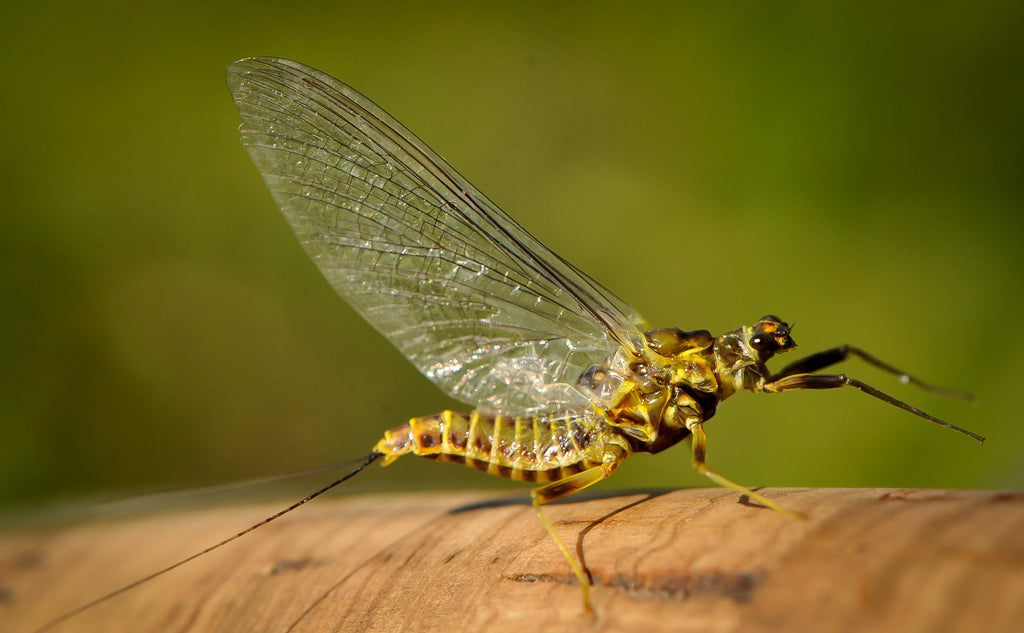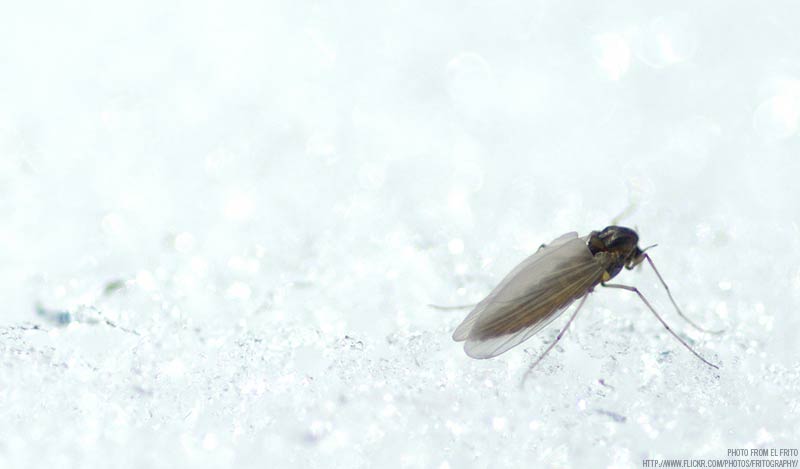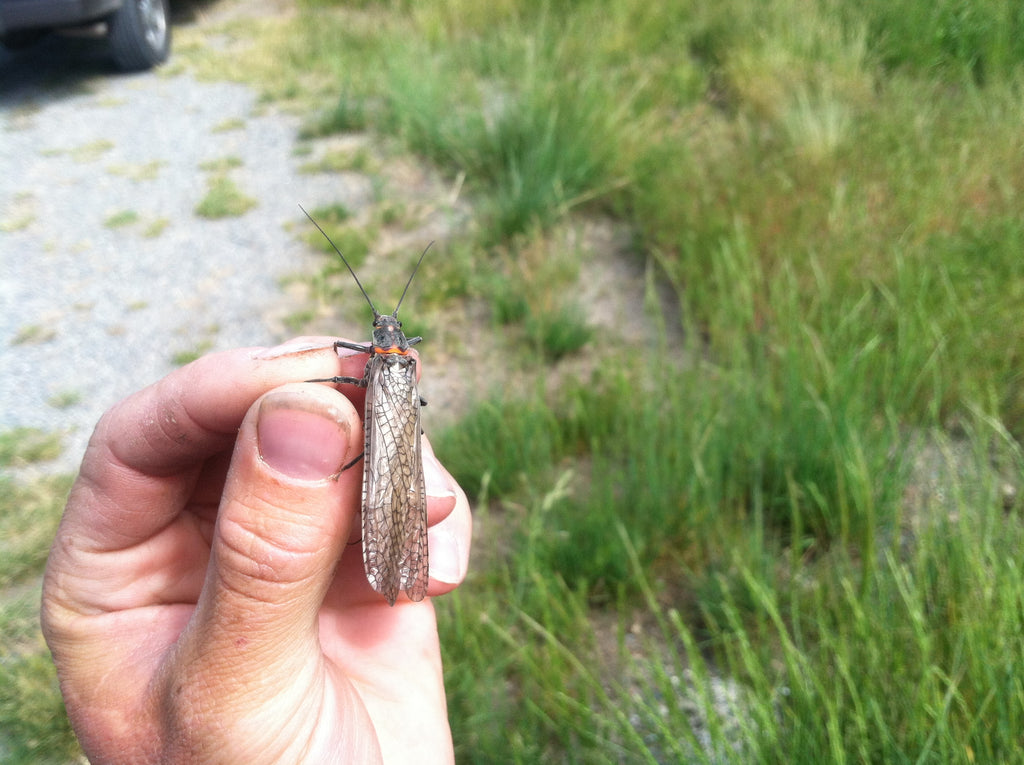Hatch Guide
Our Favorite Bug Hatches

The Yellowstone area has some of the most prolific and productive hatches in the world. The thermal features of the park add minerals to the streams, which helps support an enormous amount of aquatic insect life.
We've put together a list of some of the area's most important hatches. This isn't a complete list, so get in touch with us if you need more information or have any questions.
Stoneflies

From the giant salmon flies to the little yellow sallies, these bugs are important year round.
While most anglers think of stoneflies as the large bugs hatching in huge numbers in the late spring, or the large weighted nymphs often used as much for their sink rate as their attractiveness to the trout, one must not overlook the importance of the nymphs through out the year, especially the smaller species which are very common. While great fishing can be had on Salmonflies and Big Goldens, similarly good fishing can also be had with small smaller golden or black stonefly nymphs all through the season. Often little Golden Stones are the go to nymphs in the fall and winter.

SALMON FLY — (PTERONARCYS CALIFORNICA)
HOOK SIZES 4 – 8
These large stoneflies can provide epic fishing but are difficult hatches to time. It is usually worth the effort to fish several areas in a stream to track down the places where trout are most keyed into the big flies. Floating a big stretch of river is really the best approach. There are more Salmon Fly patterns than just about any other insect for western rivers, but the consistently productive flies all tend to be dull colored and slightly downsized.
Our rivers and when to fly fish with Salmon Flies.
- Madison River (E-L) June 25 through July 10
- Yellowstone River July 5 through July 25
- Gallatin River June 25 through July 20
- Henry’s Fork May 25 through June
-
GOLDEN STONE — (HESPEROPERLA PACIFICA)
HOOK SIZES 6 – 8
These large goldens are often overlooked by anglers chasing Salmon flies. Don’t make the same mistake, as fish key on these insects long after their larger cousins have moved on. Throughout the early summer, a big golden stone makes a great searching pattern.
-
Our rivers and when to fly fish with Golden Stone Flies.
- Madison River (E to QL) June 25 through July 15
- Yellowstone River July 1 through August 15
- Gallatin River June 25 through July 20
- Henry's Fork June 15 through July 15
Caddisflies

Caddis provide great fishing whether you're nymphing or fly fishing dry flies.
Caddisflies are very important insects to imitate throughout the season. Reliable hatches can often be found after the bulk of the Mayfly species have hatched out, making fish key on the remaining Caddis. Emerger patterns are especially important on the Madison and Firehole Rivers. Subsurface imitation of Caddis larva and pupa is a useful tool in the nymphs fisherman’s arsenal.
TRICOPTERA-MANY SPECIES
Hook Sizes: 12,14,16,18,20
-
Our rivers and when to fly fish with Caddisflies.
- Madison River (C&R) June 20 through August 15
- Firehole River May 25 through June, September 1 through October
- Yellowstone River July 15 through August 15
- Gallatin River July 1 through August 15
- Lamar & Slough Creek July 1 through August 15
- Henry’s Fork May 25 through September
Mayflies

Whether you're matching the hatch, or searching, these are the bugs many have in mind when they think of dry fly fishing.
Mayflies provide classic fishing to rising trout from April through November in the Yellowstone area. They are found in all of our trout water and their imitations provide the core of our fly selections. In addition to the great match the hatch fishing which makes mayflies beloved by head hunting anglers, fish often respond well to mayfly patterns when they are used in a searching role. Mayfly nymphs are an important food source through out the year.
PALE MORNING DUN — (EPHEMERELLA INERMIS & INFREQUENS)
HOOK SIZES 14 – 20
PMDs provide some of the best fishing of the season for dry fly anglers in the Yellowstone region. Look for insects to become smaller as hatches progress. Don’t ignore evening spinner falls for some really good fishing. PMD nymphs are also very effective during an emergence.
OUR RIVERS AND WHEN TO FLY FISH WITH PMDS
GREEN DRAKE — (DRUNELLA GRANDIS)
HOOK SIZES: 10, 12
Green Drake hatches seem as if they are tougher to hit than just about anything else, but if you get a cloudy day during the time of their peak activity, expect spectacular fishing. Always keep a few patterns on hand even if there is only an outside chance to find these flies. It does not take too many size 10 mayflies to get the fish looking to the surface.
OUR RIVERS AND WHEN TO FLY FISH WITH GREEN DRAKES
Yellowstone River July 20 – August 5BROWN DRAKE — (EPHEMERA SIMULANS)
HOOK SIZES 8, 10
Brown Drakes are often overshadowed by Green Drakes, but in general they are easier hatches to hit. Emergers, Duns and Spinners are all needed to cover a hatch. Look for them on warm calm evenings and expect to fish to rising fish well past dark.
OUR RIVERS AND WHEN TO FLY FISH WITH BROWN DRAKES
Gibbon River June 20 – July 10TINY BWO — (BAETIS PUNCTIVENTRIS)
HOOK SIZES 20, 22, 24
You can love these tiny bugs, or you can let the difficulty in fishing them ruin your day. Regardless, when you come to this area in the fall, they may be your best chance to find dry fly fishing to steadily rising fish.
OUR RIVERS AND WHEN TO FLY FISH WITH Tiny BWOs
Madison River in Yellowstone May 25 – June, September 1 – OctoberOTHER MAYFLIES
HOOK SIZES VARY
In addition to the “glory bugs” of the Mayfly world, there are other Mayflies which often provide good fishing on the rivers and lakes surrounding West Yellowstone. March Browns (12-14) are inconsistent early season finds down on the Madison (C & R) but when they are present, fish respond to them. Mid-day in April and May is the best time for hatches. The Madison has another little known bug of huge importance. Hatches of Epeorus mayflies begin in early July and last until nearly the end of August. Duns and nymphs are good flies to imitate, but it is the evening spinner falls of these insects which make for exceptional fishing. Early in the season they are often on the water along with PMD spinners, Flavs and a wide assortment of Caddis Flies. A generic rusty spinner fished in conjunction with a caddis emerger is deadly throughout the first three weeks in July. Once August rolls around, other bugs start to thin out and Epeorus spinner falls are hugely important to imitate and fish in the evening hours. Fish can often be found steadily rising to these insects well after dark, making for challenging and exciting fishing.
You can fish all of them all year long with great success
TRICOS — (TRICORYTHODES MINUTUS)
HOOK SIZES 18, 20, 22
Anglers expecting to find Callibaetis hatches are often surprised by the huge numbers of Tricos seen early in the mornings. These small bugs can be frustrating to fish, but early morning solitude amongst rising fish is easy to find.
OUR RIVERS AND WHEN TO FLY FISH WITH TRICOS
Hebgen Lake July 15 – September 15
LITTLE GREEN DRAKE — (DRUNELLA FLAVILINEA)
HOOK SIZES 14, 16
Flavs are a big deal on the Henry’s Fork, but they are often overshadowed in the mind of anglers on the Madison by PMDs. This is a big mistake. Their imitations are necessary not only for rising fish, but also make superb searching patterns.
OUR RIVERS AND WHEN TO FLY FISH WITH Little Green Drakes
Madison River July 10 – August 10BLUE WINGED OLIVES — (BAETIS TRICAUDATUS)
HOOK SIZES 16, 18, 20
If you are headed this way early or late in the season you need Baetis imitations. Cloudy days with a touch of rain or snow make for great hatches. Emergers and Duns are must haves, but one must not rule out the occasional spinner falls as a source of good fishing. Nymphs imitating BWOs are the best small nymphs on the Madison River throughout the fall, year after year.
OUR RIVERS AND WHEN TO FLY FISH WITH BWOS
Madison in Yellowstone May 25 – June, September 1 – OctoberCALLIBAETIS — (CALLIBAETIS NIGRITUS)
HOOK SIZES 14, 16
These Mayflies can hatch in spectacular numbers on Hebgen Lake. Nymphs, emergers, duns and spinners are all keyed upon. Anglers underestimate just how finicky trout can be when they are rising in stagnate water to large quantities of insects. Carry multiple patterns and vary your approach.
OUR RIVERS AND WHEN TO FLY FISH WITH CALLIBAETIS
Hebgen Lake July 15 – September 15Henry's Fork August 1 – September 15
GRAY DRAKE — (SIPHLONURUS OCCIDENTALIS)
HOOK SIZES 10, 12, 14
Gray Drakes provide a lot of action with morning spinner falls.
OUR RIVERS AND WHEN TO FLY FISH WITH GRAY DRAKES
Slough Creek July 1 – September 15Midges

Terrestrials

Terrestrial insects have become have become synonymous with late summer fishing out west. “Hopper season” is how August is summed up for many anglers for good reason. However, as fish become more pressured, they become increasingly immune to large terrestrials. Instead of #4 hoppers and big foam Chernobyl style ants, we often find ourselves fishing #14 hoppers and tiny #18 ants. Dry summers grow bigger hoppers on the whole, though many different types of hoppers are often available at any one time. As with everything else, it is important to match the naturals. Do not just tie on a #6 Club Sandwich because it pounded on fish last summer. While hoppers often bring the headlines, ants and beetles account for more fish. Be sure to keep these smaller bugs on hand. Flying ants, when encountered, can make for once in a lifetime fishing. Crickets, Spruce Moths and Bees are less common, but fish can be selective to all three. If you are headed this way from July 15 through September 30 expect to fish terrestrials as a primary option.

